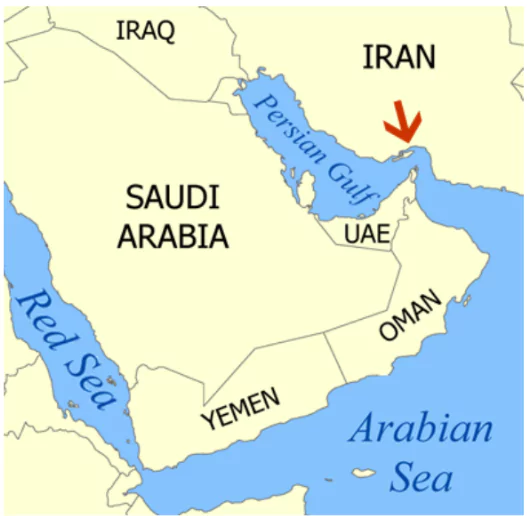
Strait of Hormuz, a narrow yet strategically critical waterway connecting the Persian Gulf with the Gulf of Oman and the Arabian Sea, remains a focal point of global geopolitics and energy security. Following recent U.S. airstrikes on Iranian nuclear facilities and the Iranian Parliament’s approval to close the Strait of Hormuz, global tensions have intensified. While the final decision rests with Iran’s Supreme National Security Council, the implications of a closure would reverberate across the globe.
The Strait of Hormuz—a narrow waterway situated between the Persian Gulf and the Gulf of Oman—is one of the most geopolitically sensitive regions in the world. As the only sea passage from the oil-rich Persian Gulf to the open ocean, its strategic relevance cannot be overstated. The Strait of Hormuz’s importance lies in its role as a global energy chokepoint: more than 20% of the world’s oil and a substantial share of its liquefied natural gas (LNG) pass through this narrow corridor daily. Recent developments, including escalating tensions between Iran and the United States, have again brought the Strait of Hormuz into international focus.
| Strait of Hormuz Overview | |
| Attribute | Details |
| Geographical Location | Between Iran (North) and Oman & UAE (South) |
| Connecting Water Bodies | Persian Gulf (West) and Gulf of Oman/Arabian Sea (East) |
| Narrowest Width | Approximately 33 km (21 miles) |
| Navigable Shipping Channel | 2 miles wide in each direction, with a 2-mile buffer zone |
| Daily Oil Flow | Around 20 million barrels (20% of global consumption) |
| Major Exporting Countries | Iran, Iraq, Kuwait, Saudi Arabia, UAE, Qatar |
| Major Importing Countries | China, India, Japan, South Korea |
| Governance | Governed by UNCLOS; controlled by Iran (North) and Oman (South) |
| Strategic Importance | Critical oil chokepoint; disruption impacts global trade and energy prices |
| Recent Tensions | Iran’s Parliament approved potential closure amid US-Iran hostilities |
| Key Ports Nearby | Bandar Abbas (Iran), Fujairah (UAE) |
Located between Iran to the north and Oman and the UAE to the south, the Strait of Hormuz is approximately 33 kilometres wide at its narrowest point. Despite this narrow passage, it is deep enough to allow the transit of Very Large Crude Carriers (VLCCs), making it essential for the movement of maritime oil traffic.

Source: Simple Wikipedia
The Strait of Hormuz map reveals the geopolitical complexities of the region. Notably, the shipping lanes—just two miles wide in each direction—pass through both Iranian and Omani territorial waters, governed under the United Nations Convention on the Law of the Sea (UNCLOS).
The Strait of Hormuz’s importance is unmatched in global energy markets. Roughly 20 million barrels of crude oil and liquefied natural gas (LNG)—representing about 20% of the world’s daily consumption—pass through this maritime artery daily. Key oil producers, including Iran, Iraq, Kuwait, Saudi Arabia, Qatar, and the UAE, rely heavily on this strait to reach international markets.
While alternative routes exist, such as Saudi Arabia’s East-West Pipeline and the UAE’s Fujairah pipeline, they cannot collectively accommodate more than 15% of the total volume that transits through the strait. Thus, a Strait of Hormuz closure would disrupt global energy supply chains and trigger price surges.
In June 2025, following coordinated U.S.–Israeli strikes on Iranian nuclear sites, Iran’s Parliament passed a motion authorising the military to close the Strait of Hormuz. Although the Strait of Hormuz closed headline is yet to materialise into full action, the threat alone has escalated global oil prices, with Brent crude briefly rising above $80 per barrel, its highest since January.
U.S. Secretary of State Marco Rubio has warned that if the Strait of Hormuz is closed by Iran, it would constitute an act of “economic suicide,” urging global players—especially China—to intervene diplomatically. With China, India, Japan, and South Korea among the largest importers of oil via the strait, the impact would be profound.
Historically, the Strait of Hormuz has been a site of military confrontation. During the Iran-Iraq War in the 1980s, attacks on oil tankers, known as the Tanker War, led to significant international naval deployments to secure the shipping lanes.
In June 2025, Iran’s parliament approved a motion to close the Strait of Hormuz, reacting to U.S. strikes on Iranian nuclear sites. Although the final decision rests with the Supreme National Security Council, this development has triggered alarm globally. Should the Strait of Hormuz be closed by Iran, it could lead to oil prices soaring to levels not seen since the early 2020s, potentially reaching $100 per barrel.
The Strait of Hormuz news headlines have been dominated by these developments. U.S. Secretary of State Marco Rubio publicly warned that closing the Strait would be “economic suicide” for Iran and urged China—a major importer of Iranian oil—to dissuade Tehran from such action.
The U.S. Navy’s Fifth Fleet, based in Bahrain, plays a critical role in ensuring the security of the Strait of Hormuz. Maritime navigation through this area is already risky due to narrow lanes, frequent electronic interference, and natural factors like fog and dust. Any Iranian attempt to mine the strait or harass commercial ships could prompt a swift military response, as seen in past crises.
Iran’s Islamic Revolutionary Guard Corps (IRGC) and naval forces have significant capabilities, including fast attack boats, submarines, and anti-ship missiles. These could be used to temporarily disrupt maritime traffic, but analysts agree that Iran lacks the capacity to enforce a prolonged blockade of the entire strait.
Iran possesses significant military capabilities, including fast-attack boats, submarines, and anti-ship missiles operated by the Islamic Revolutionary Guard Corps (IRGC). Experts believe Iran could temporarily disrupt traffic, using tactics like mining shipping lanes or harassing tankers. However, maintaining a prolonged Strait of Hormuz closure is unlikely, given the immediate countermeasures the U.S. and its allies could deploy.
Moreover, Iran’s own economy depends on oil revenues—$67 billion in the financial year ending March 2025, its highest in a decade. Disrupting oil flow would alienate allies like China, which imports nearly 90% of Iranian oil exports, and undermine Iran’s regional standing.
A closure would disproportionately affect Asian economies, as 84% of crude and 83% of LNG that pass through the strait head to Asia. Nearly half of India’s crude oil, 60% of South Korea’s, and 75% of Japan’s imports come via this route.
Any disruption could cause fuel shortages, inflation, and hinder manufacturing sectors in Asia. Although India’s Oil Minister has assured the public of diversified supplies, the global nature of oil pricing means that any regional disruption will ripple through global markets.
Due to the repeated threats of Strait of Hormuz closure, regional countries have invested in alternate export routes. For instance:
Despite these options, analysts note that these alternatives collectively represent less than 20% of the total volume typically moved through the Strait of Hormuz.
While traffic continues cautiously through the strait, tankers are taking daylight-only routes, and many are waiting off Dubai and the southern Gulf of Oman for new instructions. Maersk, a leading shipping company, has contingency plans in place but continues operations.
The Joint Maritime Information Center has issued warnings about electronic interference and congestion, while US and European intelligence agencies monitor potential escalations.
For UPSC aspirants, the Strait of Hormuz UPSC topic covers several essential areas:
Understanding the Strait of Hormuz on World Map is essential to grasp how narrow corridors can command global significance.
The Strait of Hormuz remains the most critical oil chokepoint in the world. Though Iran’s threat to close the Strait of Hormuz raises alarm, actual closure seems unlikely due to mutual economic dependencies, global naval presence, and geopolitical deterrents.
The world’s reliance on this narrow corridor underscores the vulnerability of global energy flows and the interconnectedness of diplomacy, defence, and economic stability. As Strait of Hormuz news continues to dominate headlines, its role as a barometer of Middle East stability and global oil markets cannot be overstated.
Ready to boost your UPSC 2025 preparation? Join PW’s UPSC online courses today!
The Strait of Hormuz's importance lies in being the only sea link between the Persian Gulf and the open seas, handling 20% of global oil transit.
The Strait of Hormuz on the world map is located between Iran and Oman, connecting the Persian Gulf with the Gulf of Oman and the Arabian Sea.
If the Strait of Hormuz is closed by Iran, it may disrupt global oil supply, spike prices, and strain energy security for major importers like China and India.
While threats exist, the Strait of Hormuz closed scenarios have never fully materialised. Temporary disruptions occurred during past regional conflicts.
The Strait of Hormuz map shows narrow 2-mile shipping lanes governed by international law, essential for supertankers carrying oil and LNG.
Strait of Hormuz UPSC relevance spans international relations, geography, energy security, and current affairs, vital for Mains and Prelims preparation.

<div class="new-fform">
</div>